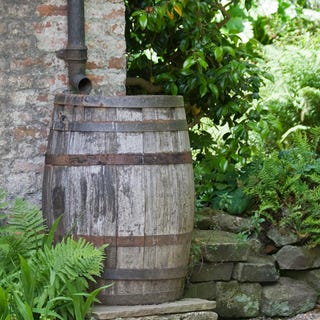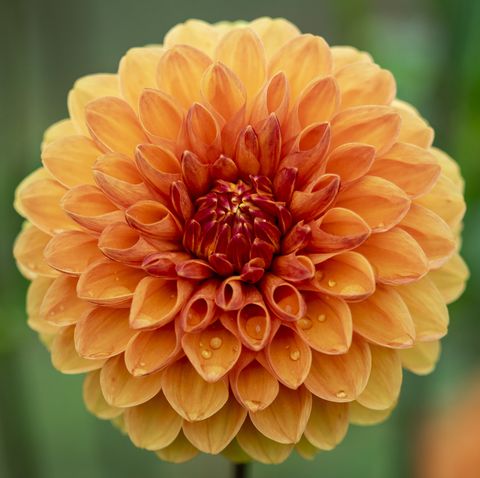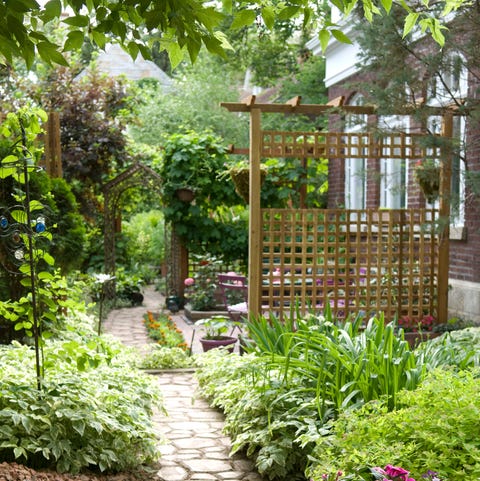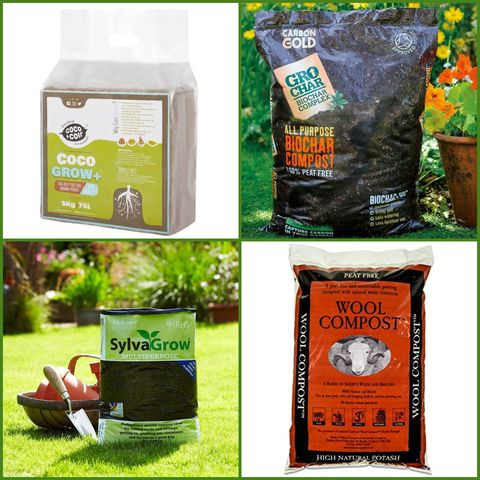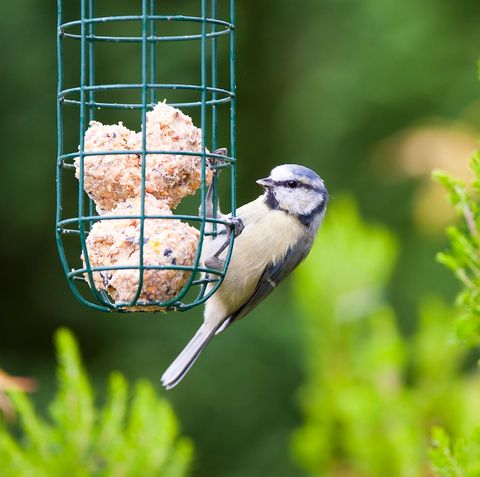A guide to the influential gardening trends of 2023, including Greek style, sustainability, slow gardening and garden glow-ups.
Just like our plants, garden trends tend to be slow-growing. But once they’ve arrived, they tend to pop-up again and again. Like coming across a perennial self seeder, some you’ll be pleased to see, others you’ll want to root out.
Last year, we covered the phenomenal, pandemic-induced uptake in gardening, the preference for homegrown produce (be it cucumbers or cut flowers), the rise in small space gardening and the idea that sustainability and wellbeing are ingrained into our outdoor spaces. You may not be surprised to hear that we expect many of these trends to stick around.
But 2022 also brought with it a new raft of challenges and lifestyle shifts, including extreme heat, droughts and hosepipe bans, the adjustment to hybrid working, and a returned wanderlust. These have influenced many of the trends we’ll see in 2023.
From creating resilient and budget-friendly spaces to the colour palette you’ll soon be swooning over, let’s dive into the garden trends that’ll be guiding our green thumbs in 2023.
1. My big fat Greek garden
Think natural stone walls, romantic bouganvillia-covered arches, rosemary hedges, clipped cypress trees and maybe even a headless torso or two (if you’re really dedicated to the theme).
When redesigning his dry garden, Monty Don was inspired by visits to Greek gardens, and specifically the use of stone intermingled with planting, which is common there. But you don’t have to go all the way to Corfu for inspiration. You’ll find plenty at the Delos Garden at Sissinghurst Castle, a Mediterranean idyll in the Kent countryside.
Recently renovated by top garden designer Dan Pearson, it features cyprus and pomegranate trees, marble columns and borders filled with drought-tolerant thymes, cistus, lavenders and Greek natives. They are deliberately chosen for their ability to tolerate the wetter winters and drier summers climate change is conjuring.
This content is imported from Instagram. You may be able to find the same content in another format, or you may be able to find more information, at their web site.
It’s this resilience which makes the Greek garden so appealing, says Katie Dubow from the Garden Media Group: “Classic Greek gardens are designed to stand up to the elements. These are scrappy gardens that make do.”
Katie recommends “using plants to shade seating areas with climbers around arches and tall trees” and describes how “olives are the IT plant in Europe right now.” Katie suggests “growing bulbs such as agapanthus and cyclamen, for a natural, timeless look.”
Additionally, raised beds and elevated patios can create the impression of a hilly terrace on a Greek island, though you’ll have to use your imagination for those dramatic views over the Aegean.
2. Water-wise gardens
The great thing about a garden inspired by the Med is you’re likely to plant it up with water-shy beauties that can put up with being parched (but also cope with the wet when it does fall).
With the UK drought expected to continue into 2023 and perhaps worsen (depending on winter rainfall), gardeners will have to carefully consider their plant choices and switch up their watering schedule. The National Allotment Society has a great guide on watering which details the exact growth stages when you can get away with not watering your veg patch.
The good news is the hosepipe ban provoked a rainwater harvesting boom we hope continues into 2023, with allotments across the nation ramping up their water storage facilities. The National Trust has also implemented a range of measures including a shift to drought-resistant plants across their gardens, increasing tree cover and shade, and the creation of wetlands.
Richard Millar, Head of Adaptation at the Climate Change Committee, said: “The recent temperatures and worrying reports about the decline in nature can feel overwhelming, but there are things people can do to help their local green spaces adapt and to feel more involved in the solutions.
“Practising sustainable gardening is one way of doing this – avoiding peat-based composts and insecticides, installing water butts, creating habitats for wildlife and choosing drought tolerant plants.”
Traditional water butts might not be the most aesthetically pleasing addition to your garden but if you’ve got the cash to splash, you can get ones shaped like raindrops, and some that double up as planters or water fountains. So if you hoard one thing this year make sure it’s H2O.
3. Tangerine dream
We can’t imagine anyone ever looking at terracotta and thinking ‘that’s SO last season’. It’s just one of those timeless materials gardeners will forever hanker after. But for 2023, the Garden Media Group have put it firmly on their hot list.
It’s not just scallop edged plant pots we’re lusting after, it’s the rich, earthy, tangerine tones of terracotta that will dominate in our gardens, in our colour choices and planting schemes and it will even spill over into our homes.
For Sarah Raven, it’s all about decadence and dahlias in 2023: “In terms of colour, I expect to see a variety of dark, rich, bright and bold colours being hugely popular in 2023. Deep velvets, rich mulberry crimsons, and autumnal oranges create a visually decadent delight!
“Dahlias in containers are a fantastic choice for smaller spaces and are set to be very popular this year. For fabulous flowers from July to October, dahlias are a must-have in every garden. Some of my favourite varieties include ‘After Dusk’ and ‘Brown Sugar’. For something vivid and bold, ‘Sword Dance’ reminds me of a toffee apple, with its warm yellow and pink tones, it’s ideal to brighten up any garden. We grow over 99 dahlias in my garden at Perch Hill, and these are some of my favourites from the collection.”
4. Garden glow-ups
With more than a third of the UK’s (typically office-based) workforce continuing to work from home, home and garden improvements will continue to get headspace and those lucky enough to have a garden will be giving their spaces the glow-up treatment.
Laurence Mann, director at Wood Finishes Direct says: “A garden is very much an extension of the home and personality. It’s essentially another room of the house. And it’s great to see it treated that way in terms of design, love and hours spent there.”
If 2022 was the year of the pergola, 2023 is the year of decorative panels. “With many town or estate gardens being overlooked, it’s no surprise that people are looking for ways to create depth and height and privacy in their garden.” Laurence adds.
With a decorative screen you get beautiful light shows which will look terrific against your newly-painted terracotta walls. Watching the pennies? Mann says picking up a paintbrush can be just as effective: “Why spend thousands upgrading a garden suite, decking, or pergola, when you could just paint them? With the cost of living going up and up, we’re seeing more customers buying products to varnish or repaint their existing, loved outdoor furniture and decking, to revamp it and give it a new lease of life.”
Which brings us nicely to our next trend…
5. Frugal gardening
As the cost of living crisis continues to bite, we expect many gardeners will be pruning their time spent in the garden centre, swapping cheerful but short-lived bedding plants for persistent perrenials, scouting for secondhand instead of new, and creating a closed-loop system in the garden.
Getting into the habit of saving seed, swapping plants with friends and buying bare-root can all reduce costs in the garden. Many garden shows in 2022 incorporated found and upcycled materials, proving the salvaged look can look more chic than shabby. Read our 15 hacks for gardening on a budget here.
6. Pass on peat, goodbye glyphosate, so long shovel?
Earlier this year, Defra announced that peat will be phased out as a growing medium for amateur gardeners by 2024. But there’s no need to wait until then as there are a number of good peat-free alternatives out there already. Why not use 2023 to experiment with different peat-free composts and find the one that works for you?
BUY NOW
Is 2023 the year the UK calls last orders on glyphosate? Although it looks like we are far from a legally-binding ban (in fact, it has been approved for use until 2025), Guernsey recently prohibited the sale of the known carcinogenic and it’s been pulled from the shelves of B&Q, Dobbies and Morrisons. Want to do your bit to pile on the peer pressure for a pesticide-free future? Sign this petition asking the UK government to ban all non-organic pesticides.
The no-dig movement, which encourages minimal soil disturbance in the garden, looks set to gather pace as a new national No-Dig Day is announced for 3rd November 2022.
7. Climate-forward gardening
Perhaps the biggest and most significant trend lies with our shifting climate. Springs are becoming cooler and drier and extreme weather events are increasingly being felt in our back gardens, bringing with them fundamental changes in when we sow, prune, feed and harvest.
As Monty Don writes in his Gardeners World Magazine column, “the old time table is no longer relevant,” gardeners must adapt, or face losses.
But we can also use the weather patten changes to our advantage, says Claire Thorpe, press officer at the RHS: “Gardeners can make the most of seasons getting longer. Gone are the days when autumn’s arrival meant putting your garden to bed. Plants including aster and salvia are putting on a good show well into November and adding late colour to gardens.”
It’s also about trusting your own intuition and noticing what nature is telling you. “Gardeners can trust in their green fingers and knowing their garden well to determine when to do things as seasons become more variable,” Claire adds. “When weeds appear, it’s time to sow hardy annuals, for example.”
Sarah Raven agrees that future gardeners will have to balance beauty and colour with what’s right by Mother Nature. “Gardeners are also becoming increasingly aware of the state of the environment and are looking at how they can make a difference, whatever size space they have. Self-sufficient, established gardens with very little bare soil provide a wealth of benefits for nature-friendly gardening.”
You can attract pollinators to your patch, however small. “Containers are great for small spaces and can be filled with vibrant colour and plants for pollinators such as our ‘Butterfly Pink Pot Collection’,” Sarah continues. “For shaded areas, rudbeckia ‘Enchanted Velvet Flame’ and ‘Enchanted Flame’ are ideal, while in sunny spots, Cobaea scandens and Coreopsis ‘Red Shift’ make perfect additions to your garden.”
8. The great garden escape
If you need an escape from the headlines, you’re certainly not alone. So it’s no wonder ‘wellbeing’ is becoming as much of a priority in our outdoor spaces as BBQ’s and beautiful blooms.
Garden designer, Juliet Sargeant, has been running a course called ‘How to Share your Garden with Wildlife’ and has noticed firsthand the impact this way of gardening can have on our mental health.
“Biophilia’ is the theory that human beings are innately drawn to the natural world and we feel restored by contact with plants and wildlife. So, finding ways, however small, to share your garden with wildlife will have the potential to improve your sense of wellbeing.”
At 2022’s Chelsea Flower Show, some gardens were designed to encourage rest, meditation and contemplation, while Kate Gould’s gold-winning Sanctuary Garden ramped up the luxury factor with tropical planting, a spa, pool and yoga area. Try creating your very own sensory garden to maximise your time in nature.
But your idea of a sanctuary might be completely different and that’s fine too, says Sargeant: “Its important to really think carefully about what you want your garden space to do for you – no matter how large or how small, it is your space, for your wellbeing.
“So, if you enjoy gardening and feel rejuvenated by that then, fine, but if you relax best by being with friends, focus on creating an entertaining space and don’t feel guilty about creating a low-maintenance garden.”
